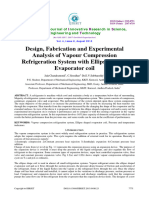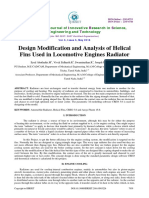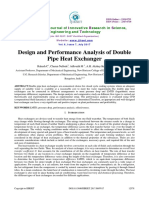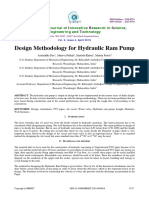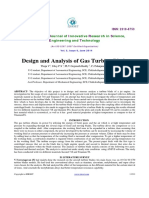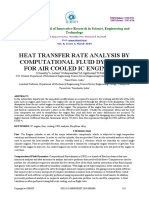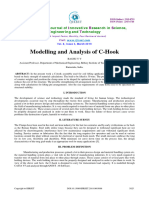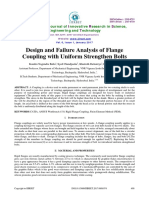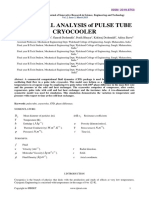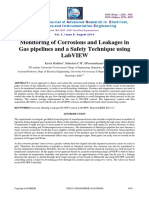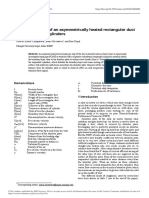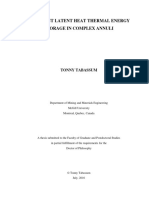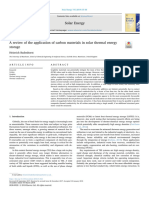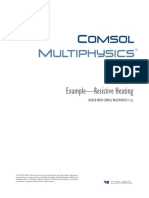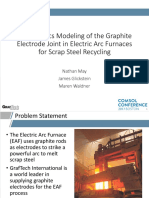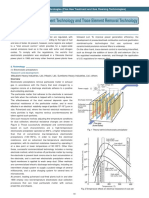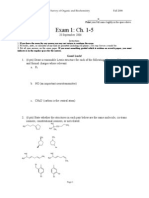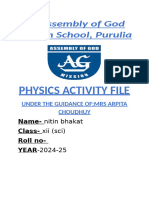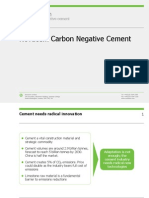Optimization of Fins Used in The Heat Exchanger Tubes
Optimization of Fins Used in The Heat Exchanger Tubes
Uploaded by
조기현Copyright:
Available Formats
Optimization of Fins Used in The Heat Exchanger Tubes
Optimization of Fins Used in The Heat Exchanger Tubes
Uploaded by
조기현Original Title
Copyright
Available Formats
Share this document
Did you find this document useful?
Is this content inappropriate?
Copyright:
Available Formats
Optimization of Fins Used in The Heat Exchanger Tubes
Optimization of Fins Used in The Heat Exchanger Tubes
Uploaded by
조기현Copyright:
Available Formats
ISSN(Online) : 2319-8753
ISSN (Print) : 2347-6710
International Journal of Innovative Research in Science,
Engineering and Technology
(An ISO 3297: 2007 Certified Organization)
Vol. 4, Issue 7, July 2015
Optimization of Fins Used in the Heat
Exchanger Tubes
Milbin Koshy
Department of Mechanical Engineering, Srinivas Institute of Technology, Mangaluru, Karnataka, India
ABSTRACT: The concept of heat transfer through annular fin of rectangular profile is one of the methods for improving
heat transfer rate by natural convection in heat exchangers. Radial fins are used in heat exchange devices to enhance the
heat transfer rate. Temperatures vary with the geometry of the fins and along the fluid flow direction. The fin geometry
has the affects on the flow direction and causes the temperature changes. Numerical analyses are carried out to examine
finned tube heat exchanger.
KEYWORDS: Extended surfaces, Heat Transfer, optimization, Temperature distribution, Heat exchanger.CFD
I. INTRODUCTION
Annular fins find various applications in heat exchangers, in specialized installations of single and double-pipe heat
exchangers, in electrical apparatus, on cylinders of air cooled internal-combustion engines, etc. In a conventional heat
exchanger heat is transferred from one fluid to another through a metallic wall. The rate of heat transfer is directly
proportional to the extent of the wall surface, the heat transfer coefficient and to the temperature difference between one
fluid and the adjacent surface. If thin metals (fins) are attached to the surface extending to one fluid so total surface for
heat transfer is thereby increased. Many of the basic engineering data for modeling systems comes from measurements
of heat capacity and thermal conductivity. Fin is a surface that extends from an object to increase the rate of heat transfer
to or from the environment by increasing convection. The amount of conduction, convection or radiation of an object
determines the amount of heat it transfers. Increasing the temperature difference between the object and the
environment, increasing the convection heat transfer coefficient or increasing the surface area of the object increases the
heat transfer. Sometimes it is not economical or it is not feasible to change the first two options. Adding a fin to an object,
however, increases the surface area and can sometimes be an economical solution to heat transfer problems. Annular fins
are used extensively in heat exchange de-vices to enhance the heat transfer rate. For various fins can dissipate different
amounts of heat because of the different shape and geometry. The goal of fin optimization is to find the shape of the fin
which would maximize the heat dissipation for a given fin volume. Computational fluid dynamics (CFD) has become
grate role
in recent years for the analysis of heat transfer in different conditions
II. DETAILS OF EXPERIMENT
Experimental analysis was done on the heat exchanger (Finned tube heat exchanger) model, inside and outside
convection heat transfer coefficients are estimated by passing preheated air through the tube and over the tube by the help
of draught fan. Temperatures at the fin tip and base are checked by thermocouple.
A. Specifications of Finned Tube Heat Exchanger
Inner diameter of bare tube: 0.051m
Outer diameter of bare tube: 0.064m
Tube material: Aluminum
Copyright to IJIRSET DOI:10.15680/IJIRSET.2015.0407186 6542
ISSN(Online) : 2319-8753
ISSN (Print) : 2347-6710
International Journal of Innovative Research in Science,
Engineering and Technology
(An ISO 3297: 2007 Certified Organization)
Vol. 4, Issue 7, July 2015
Length of Intercooler: 0.163m
No. of fins: 14
Fin material: Cast Iron
Thickness of each fin:2.73 m
Type of fins: Radial fins of rectangular cross section
Height of fin:11.325 m
B. Experimental Observation
Temperatures at different positions of fin are measured by using infrared thermocouple
Table 1: Temperature of fins in(0C)
Sl.No. Temp ( 0C)
1 77
2 76
3 76.2
4 75
5 75.6
6 76.3
7 76.8
8 77
9 75.5
10 75.3
11 73.8
12 74
13 73.6
14 70
Fig .1. Radial fin of rectangular profile
Copyright to IJIRSET DOI:10.15680/IJIRSET.2015.0407186 6543
ISSN(Online) : 2319-8753
ISSN (Print) : 2347-6710
International Journal of Innovative Research in Science,
Engineering and Technology
(An ISO 3297: 2007 Certified Organization)
Vol. 4, Issue 7, July 2015
Estimation of inside convective heat Transfer coefficient
Mean temperature of air inside the intercooler = 80
Discharge (Q)= Cd a0( )
Where = Cd coefficient of discharge of orifice meter= 0.62
a0 =
Ha=
d 0= 20mm
a0=3.14 m2
Q=0.62 3.14 ( )
Q= 3.79
Vair inside=
=
=51 m
Vair inside =1.85m/s
Re=7788.33
Dittus-Boeltor equation for fully developed flow is considered for evaluation of inside convective heat transfer coefficient
Nu=0.023
Nu=
C. Estimation of Outside Convective Coefficient
Film temperature of air =50 0C
Properties of air are evaluated at 50 0C,
Density ( ) =1.093 Kg/
Kinematic viscosity ( ) = 17.95 ×
Thermal conductivity (K) =0.03047 W/m.K
Prandtl number (Pr) =0.692
flow across cylinders is considered for evaluation of outside convective heat transfer coefficient
Nu=C
Re=
=equivalent diameter of the fin
=
=
=
=
=
=18.69
= =
=0.3267m
=0.04668 m
Copyright to IJIRSET DOI:10.15680/IJIRSET.2015.0407186 6544
ISSN(Online) : 2319-8753
ISSN (Print) : 2347-6710
International Journal of Innovative Research in Science,
Engineering and Technology
(An ISO 3297: 2007 Certified Organization)
Vol. 4, Issue 7, July 2015
Re=7788.33
For the calculated Reynold’s number, the value of C and m are referred from the heat transfer data book as,
C=0.193
m=0.618
Nu=0.193(6111.97)0.618(0.6974)0.333
=26.32
D. Optimization of Fins
Three different radial fin profiles are used for the fin shape optimization.
The shapes of fins, used in simulations, are shown in Fig. 2 (a)-(c).
Fig .2. Radial fin Profiles (a),(b),(c)
Table 2: Tube and Fin Dimensions
Parameters Fin version
used for fin a b c
dimension
(m) 0.032 0.032 0.032
(m) 0.052 0.052 0.052
(m) - 0.042 0.042
(m) 0.005 0.005 0.005
(deg) 90 90 92
(deg) 180 179 182
Copyright to IJIRSET DOI:10.15680/IJIRSET.2015.0407186 6545
ISSN(Online) : 2319-8753
ISSN (Print) : 2347-6710
International Journal of Innovative Research in Science,
Engineering and Technology
(An ISO 3297: 2007 Certified Organization)
Vol. 4, Issue 7, July 2015
Each fin operated as a part of the heat exchangers and the initial thermal as well as flow Conditions are the same for all
fins:
Temperature difference of the fluid is found out by numerically and solid volume is also calculated for different profiles
for finding the appropriate optimization function for different profiles
Table 3: Optimization function
Air velocity =3( )
FIN PROFILES
(a) (b) (c)
( ) 29.38 28.61 28.93
( ) 2.25 1.16 7.41
( ) 3.79 3.79 3.79
4948.89 9347.57 14796.85
III. RESULT AND DISCUSSION
The heat flux depends on the temperature difference between the/tube and air temperatures. In reality, these temperatures
vary along the cross section of the air stream and along the fluid flow direction. All results are calculated considering the
air flow and its streamline deviations caused by the geometry configuration and compared with the actual result of
circular fins of rectangular cross sections. The model allows considering the heat transfer in three directions.
The results illustrate how the fin dimensions influence the defined optimization function for a specified air rates. The
best results, among three profiles, are received for profile (c) for higher inlet air velocities. In that case, optimization
value ε is higher than profiles (a) and (b).The same conclusion may also be reached with the flow analysis. Evaluated the
streamlines for all three models, the influence of fin shape on mass flow distribution is seen from ANSYS FLUENT. The
examples are demonstrated from Fig 5.4 to 5.36 for same air inlet velocities. The air that comes through the heat
exchanger flows over the fin
Copyright to IJIRSET DOI:10.15680/IJIRSET.2015.0407186 6546
ISSN(Online) : 2319-8753
ISSN (Print) : 2347-6710
International Journal of Innovative Research in Science,
Engineering and Technology
(An ISO 3297: 2007 Certified Organization)
Vol. 4, Issue 7, July 2015
Fig .3. Air streamlines for fin profile (a)
Fig .4. Air streamlines for fin profile (b)
Fig .5. Air streamlines for fin profile (c)
IV. CONCLUSIONS
The rate of the heat transfer does not depend only on wall surface dimensions, heat transfer coefficient and the
temperature difference between the fluid that surrounds the plate and the plate surface temperature. The air velocity and
the fin shape are also essential because the fin profile influences the flow direction. For heat exchangers, built with many
fins and designed for real industry, it is important to pay attention to and calculate the heat transfer considering the fluid
flow and flow paths.
It should be also mentioned that if the fin is positioned into an air stream, the flow applies to a force from the fin tip
surface in the direction of the oncoming flow (drag). The resistance of the body results in a pressure drop. The fin and
tube surface orientation also modifies the resistance of the body that results in a pressure drop.
Copyright to IJIRSET DOI:10.15680/IJIRSET.2015.0407186 6547
ISSN(Online) : 2319-8753
ISSN (Print) : 2347-6710
International Journal of Innovative Research in Science,
Engineering and Technology
(An ISO 3297: 2007 Certified Organization)
Vol. 4, Issue 7, July 2015
V. ACKNOLEGEMENT
The Fertilizers and Chemicals Travancore Limited (FACT Ltd), Kochi, Kerala, India, management for their support in
providing the operational data of the boiler, specification and other data related to this study
REFERENCES
[1] Antonio Campo.Temperature/Heat Analysis of Annular Fins of Hyperbolic Profile Relying on the Simple Theory for Straight Fins of Uniform
Profile,vol 130.
[2] piotr wais,Fluid flow consideration in fin-tube heat exchanger optimization , Vol. 31(2010), No. 3, 87–104
[3] K. J. Moleofane and R. J.Moitsheki,Comparison of Exact Solutions for Heat Transfer in Extended Surfaces of Different Geometries, Vol.2014, Article
ID 417098
[4] Sikindar Baba Md , Nagakishore.S ,and M. Bhagvanth Rao Thermal Analysis on a Finned Tube Heat Exchanger of a Two Stage Air Compressor, Vol.
2 Issue V, May 2014
[5] Esmail M.A.and Mokheimer, Performance of annular fins with different profiles subject to variable heat transfer coefficient,International Journal of
Heat and Mass Transfer 45 (2002) 3631–3642
[6] Prajesh Paul, Ram C Sharma, Rohit Bezewada, Mohammad Wakeel, and SM Murigendrappa, Comparative Study Of Thermal Stress Distributions In
Fins Operating At High Temperature For Different Profiles And Materials, AMAE 2011,
[7] Hossain Nemati and Mohammad Moghimi, Numerical Study of Flow Over Annular-Finned Tube Heat Exchangers by Different Turbulent Models,
ISSR Journals Vol. 6(3) 2014
Copyright to IJIRSET DOI:10.15680/IJIRSET.2015.0407186 6548
You might also like
- AWWA G200-15 - Distribution Systems Operation and ManagementDocument32 pagesAWWA G200-15 - Distribution Systems Operation and ManagementHồ Trung ThôngNo ratings yet
- 123 35 DesignDocument8 pages123 35 Designnaing linNo ratings yet
- Helical FinsDocument7 pagesHelical Finsmayank srivastavaNo ratings yet
- Design and Performance Analysis of Double Pipe Heat ExchangerDocument7 pagesDesign and Performance Analysis of Double Pipe Heat ExchangerAidiaiem KhawaijNo ratings yet
- Design Methodology For Hydraulic Ram Pump: Nternational Ournal of Nnovative Esearch in Cience, Ngineering and EchnologyDocument9 pagesDesign Methodology For Hydraulic Ram Pump: Nternational Ournal of Nnovative Esearch in Cience, Ngineering and EchnologyAshutosh DongarwarNo ratings yet
- Experimental Analysis of Water Distribution Network and Its Hydraulic Simulation by EpanetDocument8 pagesExperimental Analysis of Water Distribution Network and Its Hydraulic Simulation by EpanetFisehaNo ratings yet
- Performanceand Optimizationof Capillary Tube Length Ina Split Type Air Conditioning SystemDocument12 pagesPerformanceand Optimizationof Capillary Tube Length Ina Split Type Air Conditioning Systemqf.mehdiNo ratings yet
- Analysis of A Condenser in A Thermal Power Plant For Possible Augmentation in Its Heat Transfer PerformanceDocument6 pagesAnalysis of A Condenser in A Thermal Power Plant For Possible Augmentation in Its Heat Transfer PerformanceZeeraiNo ratings yet
- 42 RocketDocument16 pages42 Rocket8059No ratings yet
- Design, Analysis and Testing of Spindle For High Speed CNC Lathe MachineDocument8 pagesDesign, Analysis and Testing of Spindle For High Speed CNC Lathe MachineArif NurrohmanNo ratings yet
- Design, Development and Automation of Hydraulic Broaching MachineDocument8 pagesDesign, Development and Automation of Hydraulic Broaching MachineMuftah AhmedNo ratings yet
- Design and Analysis of Gas Turbine Blade: ISSN: 2319-8753 I J I R S E TDocument7 pagesDesign and Analysis of Gas Turbine Blade: ISSN: 2319-8753 I J I R S E Tmaji heNo ratings yet
- Trends in MachinetoolsDocument8 pagesTrends in Machinetoolsmohan SRNo ratings yet
- Heat Transfer Enhancement by Modification in Hexagon TubeDocument8 pagesHeat Transfer Enhancement by Modification in Hexagon TubeIJRASETPublicationsNo ratings yet
- 52 - Paper ID IJ60606050Document7 pages52 - Paper ID IJ60606050reiferNo ratings yet
- Design Modification & Analysis of Header-Tube Joint in Heat ExchangerDocument8 pagesDesign Modification & Analysis of Header-Tube Joint in Heat Exchangersreenu mNo ratings yet
- Design, Fabrication and Performance of Twisted Tube Heat ExchangerDocument5 pagesDesign, Fabrication and Performance of Twisted Tube Heat ExchangerIJRASETPublicationsNo ratings yet
- Ijesrt: International Journal of Engineering Sciences & Research TechnologyDocument6 pagesIjesrt: International Journal of Engineering Sciences & Research Technologysujata khartadeNo ratings yet
- Experimental Analysis of Fin Tube and Bare Tube Type Tube-In-Tube Heat ExchangerDocument6 pagesExperimental Analysis of Fin Tube and Bare Tube Type Tube-In-Tube Heat ExchangerMohammed Abdul Hai CHE VI ANo ratings yet
- 14 Optimization of Shell Tube Heat Exchanger by Baffle Inclination Baffle Cut-1Document5 pages14 Optimization of Shell Tube Heat Exchanger by Baffle Inclination Baffle Cut-1PramodNo ratings yet
- 268 Gearless MergedDocument53 pages268 Gearless Mergedonkargawade07No ratings yet
- Gearless Transmission Mechanism and Its ApplicationsDocument6 pagesGearless Transmission Mechanism and Its ApplicationsChandrasekhar KolluNo ratings yet
- Influence of Vortex Generator On AugmentDocument9 pagesInfluence of Vortex Generator On AugmentbansodevhNo ratings yet
- Finite Element Modelling and Analysis of Hot Turning OperationDocument15 pagesFinite Element Modelling and Analysis of Hot Turning OperationIJRASETPublicationsNo ratings yet
- Pipe Size Calculation For Water SupplyDocument5 pagesPipe Size Calculation For Water SupplyIJRASETPublicationsNo ratings yet
- 2016-Prasad-55 - Fluid - FSI of HDB Using CFD-IJIRSETDocument9 pages2016-Prasad-55 - Fluid - FSI of HDB Using CFD-IJIRSETAlex CooperNo ratings yet
- 30 CFD AnalysisDocument7 pages30 CFD AnalysisNikit VhatkarNo ratings yet
- A Review On Helical Coil Heat ExchangerDocument8 pagesA Review On Helical Coil Heat ExchangerSukhadip ChouguleNo ratings yet
- PaperpublisherudayDocument8 pagesPaperpublisherudayDeniz AtmacaNo ratings yet
- Treatment of Domestic Wastewater by Advanced Method of ElectrocoagulationDocument7 pagesTreatment of Domestic Wastewater by Advanced Method of ElectrocoagulationEnrique MartinezNo ratings yet
- Design, Fabrication and Performance Analysis of A Parabolic Trough Solar Collector Water HeaterDocument6 pagesDesign, Fabrication and Performance Analysis of A Parabolic Trough Solar Collector Water HeaterdjemNo ratings yet
- Heat Transfer Rate Analysis by Computational Fluid Dynamics For Air Cooled Ic Engine FinsDocument7 pagesHeat Transfer Rate Analysis by Computational Fluid Dynamics For Air Cooled Ic Engine FinsHaran PrabhaNo ratings yet
- Experimental and Comparison Study of Heat Transfer Characteristics of Wickless Heat Pipes by Using Various Heat InputsDocument12 pagesExperimental and Comparison Study of Heat Transfer Characteristics of Wickless Heat Pipes by Using Various Heat InputsIJRASETPublicationsNo ratings yet
- Case Study On Double Tube Sheet-2086Document13 pagesCase Study On Double Tube Sheet-2086Ravi GurugeNo ratings yet
- 54 Design PDFDocument5 pages54 Design PDFSayyed ArifNo ratings yet
- Experimentation On Fabrication of Double Pipe Heat ExchangerDocument11 pagesExperimentation On Fabrication of Double Pipe Heat ExchangerIJRASETPublicationsNo ratings yet
- 11 IV April 2023Document11 pages11 IV April 2023Fawziyyah AgboolaNo ratings yet
- 138 CFDDocument30 pages138 CFDAryan MarneNo ratings yet
- Review Enhancement of Heat Transfer Through Modification in FinsDocument9 pagesReview Enhancement of Heat Transfer Through Modification in FinsIJRASETPublicationsNo ratings yet
- 10 VII July 2022Document20 pages10 VII July 2022IJRASETPublicationsNo ratings yet
- CFD Analysis of Shell and Coil Heat Exchanger by Using Different Mass Flow Rate For Hot and Cold FluidDocument19 pagesCFD Analysis of Shell and Coil Heat Exchanger by Using Different Mass Flow Rate For Hot and Cold FluidIJRASETPublicationsNo ratings yet
- Jagdale PDFDocument6 pagesJagdale PDFSachin BorseNo ratings yet
- Ijesrt: International Journal of Engineering Sciences & Research TechnologyDocument12 pagesIjesrt: International Journal of Engineering Sciences & Research TechnologyasfsfsafsafasNo ratings yet
- 66 3 ModellingDocument9 pages66 3 ModellingReza JavadianNo ratings yet
- Solar Air Conditioning SystemDocument9 pagesSolar Air Conditioning SystemIJRASETPublicationsNo ratings yet
- Technological University of The PhilippinesDocument7 pagesTechnological University of The PhilippinesJohn Reigh CatipayNo ratings yet
- Top Journals 16novDocument11 pagesTop Journals 16novnaresh kotraNo ratings yet
- Effect of Various Parameters On Working Condition of ChillerDocument8 pagesEffect of Various Parameters On Working Condition of ChillerAbdul Fatir KhanNo ratings yet
- Performance of Convergent and Divergent NozzleDocument6 pagesPerformance of Convergent and Divergent NozzleIJRASETPublicationsNo ratings yet
- Design and Failure Analysis of Flange Coupling With Uniform Strengthen BoltsDocument7 pagesDesign and Failure Analysis of Flange Coupling With Uniform Strengthen Boltsamir moniriNo ratings yet
- 11 Numerical AnalysisDocument9 pages11 Numerical Analysisعزالدين حسنNo ratings yet
- ANSYS CFD and Experimental Comparison of Various Parameters of A Solar StillDocument11 pagesANSYS CFD and Experimental Comparison of Various Parameters of A Solar StillsepehrNo ratings yet
- 23 PerformanceDocument7 pages23 Performancesafiya sultanaNo ratings yet
- 83 Determination PDFDocument7 pages83 Determination PDFprabhjyot_uclNo ratings yet
- Computational Fluid Flow AnalysisDocument6 pagesComputational Fluid Flow AnalysisRiddhesh PatelNo ratings yet
- Combined Autoclave and Water Purification System Using Solar EnergyDocument3 pagesCombined Autoclave and Water Purification System Using Solar EnergyIJIRSTNo ratings yet
- Monitoring of Corrosions and Leakages in Gas Pipelines and A Safety Technique Using LabviewDocument7 pagesMonitoring of Corrosions and Leakages in Gas Pipelines and A Safety Technique Using LabviewSinn RavenNo ratings yet
- Experimental Investigation of Heat Transfer Enhancement by Using Clockwise and Counter - Clockwise Corrugated Twisted Tape InsertsDocument10 pagesExperimental Investigation of Heat Transfer Enhancement by Using Clockwise and Counter - Clockwise Corrugated Twisted Tape InsertsIJIERT-International Journal of Innovations in Engineering Research and TechnologyNo ratings yet
- Numerical Study of An Asymmetrically Heated Rectangular Duct With Suspended CylindersDocument7 pagesNumerical Study of An Asymmetrically Heated Rectangular Duct With Suspended CylindersGauravNo ratings yet
- Comparative Thermal Analysis of Fin of I.C. Engine With Extensions IJERTV6IS040377 PDFDocument8 pagesComparative Thermal Analysis of Fin of I.C. Engine With Extensions IJERTV6IS040377 PDFAhmad FaizalNo ratings yet
- Transient Latent Heat Thermal Energy Storage in Complex AnnuliDocument358 pagesTransient Latent Heat Thermal Energy Storage in Complex Annuli조기현No ratings yet
- Fokaides PaperDocument7 pagesFokaides Paper조기현No ratings yet
- JONAYAT - Transient Model of Meniscus and Slag Consumption - Published VersionDocument23 pagesJONAYAT - Transient Model of Meniscus and Slag Consumption - Published Version조기현No ratings yet
- Carbon As TES PaperDocument34 pagesCarbon As TES Paper조기현No ratings yet
- CFD Simulation of Process-Driven Particle Fragmentation in A Coal Bed GasifierDocument13 pagesCFD Simulation of Process-Driven Particle Fragmentation in A Coal Bed Gasifier조기현No ratings yet
- Thermal Science and Engineering Progress: SciencedirectDocument22 pagesThermal Science and Engineering Progress: Sciencedirect조기현No ratings yet
- HRSG CFD AnalysisDocument185 pagesHRSG CFD Analysis조기현No ratings yet
- Manual Optris CTlaserDocument98 pagesManual Optris CTlaser조기현No ratings yet
- Example-Resistive Heating: Solved With Comsol Multiphysics 3.5ADocument15 pagesExample-Resistive Heating: Solved With Comsol Multiphysics 3.5A조기현No ratings yet
- Multiphysics Modeling of The Graphite Electrode Joint in Electric Arc Furnaces For Scrap Steel RecyclingDocument28 pagesMultiphysics Modeling of The Graphite Electrode Joint in Electric Arc Furnaces For Scrap Steel Recycling조기현No ratings yet
- Arif Zaki Ariffin - 12323 - Dissertation Report-GoodDocument62 pagesArif Zaki Ariffin - 12323 - Dissertation Report-Good조기현No ratings yet
- Design Optimization of Variable Geometry Microchannel Heat ExchangersDocument11 pagesDesign Optimization of Variable Geometry Microchannel Heat Exchangers조기현No ratings yet
- Viscocity and Plasticity in Rubber CompoundingDocument1 pageViscocity and Plasticity in Rubber CompoundingBharat ChatrathNo ratings yet
- Expired Drugs and Medical Supplies19Document2 pagesExpired Drugs and Medical Supplies19JohanNo ratings yet
- SSP SyllabusDocument2 pagesSSP SyllabusHaze Subin CNo ratings yet
- Electrostatic PrecipitorsDocument2 pagesElectrostatic PrecipitorsTeererai KaguraNo ratings yet
- Re Alkalization 1Document2 pagesRe Alkalization 1Dikshant Hasbe100% (1)
- Importance of Recycling Education: A Curriculum Development at WSUDocument9 pagesImportance of Recycling Education: A Curriculum Development at WSUkarinNo ratings yet
- Reduction To Ozonides: Spectroscopic PropertiesDocument2 pagesReduction To Ozonides: Spectroscopic PropertiesvibhuNo ratings yet
- Ideal Chemistry - A Complete Approach For 0 Level (Introduction)Document460 pagesIdeal Chemistry - A Complete Approach For 0 Level (Introduction)ibandarich111No ratings yet
- Rev - Per Trends - Bonding-13-14-AnswersDocument5 pagesRev - Per Trends - Bonding-13-14-AnswersSukhNo ratings yet
- SSC General Studies - Cracker (WWW - Qmaths.in)Document135 pagesSSC General Studies - Cracker (WWW - Qmaths.in)Shubhra MathurNo ratings yet
- Electrorheological Materials and Potential Applications in TextilesDocument4 pagesElectrorheological Materials and Potential Applications in TextilesArt PlanteurNo ratings yet
- Biodegradable Polymers For Sustainable Packaging Applications - A ReviewDocument12 pagesBiodegradable Polymers For Sustainable Packaging Applications - A ReviewAngelito AraxielNo ratings yet
- Food Chemistry Practical 4Document5 pagesFood Chemistry Practical 4Yan Chen0% (1)
- SJD (CEP) Vertical Multistage Can Pump For Condensate ExtractionDocument5 pagesSJD (CEP) Vertical Multistage Can Pump For Condensate ExtractionClke OGNo ratings yet
- Suspension ColloidsDocument27 pagesSuspension Colloidsalice mapanaoNo ratings yet
- CHM 421 - Exp3Document12 pagesCHM 421 - Exp3AMIRAH ISHAMI ISHAKNo ratings yet
- Exam 1: Ch. 1-5: 1. (6 PTS) Draw A Reasonable Lewis Structure For Each of The Following, Showing All Lone Pairs A. PDocument7 pagesExam 1: Ch. 1-5: 1. (6 PTS) Draw A Reasonable Lewis Structure For Each of The Following, Showing All Lone Pairs A. Pnmarti31No ratings yet
- D.R.Coats Ink & Resins Pvt. LTD - AddDocument1 pageD.R.Coats Ink & Resins Pvt. LTD - AddMOHAMEDNo ratings yet
- Chemistry Project OnDocument11 pagesChemistry Project Onsontu.nbNo ratings yet
- Comparison of Acids and BasesDocument5 pagesComparison of Acids and BasesSANDEEP SINGH100% (1)
- Form-A-Blok As: Acid-Soluble Lost Circulation PillDocument1 pageForm-A-Blok As: Acid-Soluble Lost Circulation PillMr. Hein Htet SoeNo ratings yet
- HandlerDocument58 pagesHandlerHiba MohanadNo ratings yet
- Water CycleDocument6 pagesWater CycleVal Daryl AnhaoNo ratings yet
- Slip CastingDocument15 pagesSlip CastingLuciano MagalhãesNo ratings yet
- Chemistry and Technology of Explosives - Volume II - Tadeusz UrbanskiDocument526 pagesChemistry and Technology of Explosives - Volume II - Tadeusz Urbanskisilentpro74No ratings yet
- Kota Career Academy: Chemistry DPDDocument5 pagesKota Career Academy: Chemistry DPDDeepNo ratings yet
- NovacemDocument17 pagesNovacemcuajo20% (2)
- BCH 332 Lectures 1 and 2 0Document33 pagesBCH 332 Lectures 1 and 2 0asdNo ratings yet
- Chapter 10 - VLE From An Equation of StateDocument12 pagesChapter 10 - VLE From An Equation of StateBananaliksNo ratings yet

